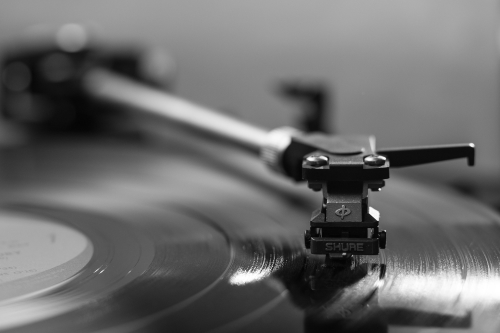When I was a budding sound engineer with the U.S. Air Force Band during the 1990s, one of my mentors was a consultant in the Washington, D.C. area named George Weber.
George was a somewhat eccentric guy and definitely a dyed-in-the-wool audiophile. He had done some modifications to the band’s K&H studio loudspeakers, and those things did sound amazingly good.
George once invited me to his home and played some record albums on his super-high-end stereo system. The turntable alone was amazing – it had an air bearing for the spindle and a linear-tracking arm also with an air bearing.
To keep the air noise to a minimum, the air pump was in a separate room. I don’t believe I’ve ever heard LPs sound that amazing. And if I remember correctly, he had a personal pair of K&H loudspeakers in ceramic housings.
For the listening session, George suggested I bring some of my favorite (and familiar) albums, which leads me to my point: the material we choose for critical listening and sound system tuning should satisfy several criteria.
First, we should very familiar with it. Second, it should be well recorded. And third, it helps if we like it.
George stressed something else about critical listening: limit the sections of music to specific passages, and repeat those passages over and over again during evaluations.
Knowing It
What’s so important about being intimately familiar with the playback material? The most obvious answer is that when we are familiar with something, we notice differences very readily.
In a general sense, we best know the sound of the human voice, particularly the voices of friends and family. Thus at least one of the recordings to use for evaluation of a system is something containing a familiar voice, because right away, it should clearly show problems, particularly in the midrange. (As a side note, this is one of the reasons loudspeaker designers work so hard to get things right in the midrange.)
Voice alone usually isn’t enough, since it covers a limited frequency and dynamic range, while we’re usually dealing with musical sources. But the same rule of familiarity applies when choosing material that covers the whole range, because problems with the bass, drums, guitars, etc. should be obvious if we really know the tracks.
One of my favorite tracks was “Famous Blue Raincoat” performed by Jennifer Warnes and engineered by George Massenburg. The voice is so clearly represented, and so are the strings and upright bass – no drums though.
Robert Scovill shared a different but related approach with me back in those days. For a Tom Petty tour during the mid-1990s, he recorded each raw microphone input to ADAT (remember those?). Then for the next show’s sound check, he would play the tracks from the previous show to help suss out the system and acoustics of the room.
I thought that was a unique and cool idea at the time, and it certainly satisfied the familiarity issue, with the added bonus of being recorded from live instruments. (We call it a virtual sound check these days.)
Not Created Equal
Recordings should be the best quality possible, particularly in this era of iPods, iPhones and other MP3 players. If you’re ripping the songs yourself, use first-rate CDs or other original source material, as opposed to, say, the first-edition CD from 1985 that was cut from the LP masters and sounds terrible.
Instead, use a more recently re-mastered version, and set the conversion process to use the highest bit rate available.
Today we can readily choose AIFF, .WAV, and other lossless formats. So what if they’re larger files? Do we really need 10,000 songs in our pocket? How about a couple dozen really good ones that are well recorded and properly ripped?
One of the reasons I loved that Jennifer Warnes recording was that it sounded flat-out amazing for its day. Another cut on that album, “Bird on a Wire,” has great drums, too. Between those two songs, I often got a pretty good idea of the condition of the system and the state of the room.
Another superb track is Patricia Barber’s “Modern Cool” recorded by Jim Anderson. Check this one out for sure – super clear voice, sublime piano, upright bass to please upright bass players, and incredibly realistic drums. It’s not a pop/rock record, though, and you probably need some of that genre in your collection.
However, be picky – not all pop/rock records are created equal. You may not like Lady Gaga as an artist, but the production values of many of her recordings are pretty amazing. Check out “Bloody Mary” from the Born This Way album, if you haven’t already.
The bottom line is that most of what we hear today on the radio, at shows, on our personal music players and in our cars is far from ideal. Low bit rates, second-rate recordings, and shows that are too loud and too distorted all work to undermine our frame of reference. I’ve said it before but it bears repeating: listen to live acoustic music and then find some recordings that sound like that.
At the same time, I’m not at all opposed to creating new sounds in the studio or on the stage that never existed before. Just do so with fidelity and integrity.
Certain Aspects
Finally, try to avoid tracks that you don’t care for, no matter how amazing they might sound and/or how many others like them. I have my personal collection of favorites for this purpose, and you should have yours.
This gets back to the thing about short passages that get repeated over and over during the course of critical listening and system tuning. By doing so, we can really start to pick out how certain aspects of the sound change when the parameters of the system change. And if you like the tracks, this process won’t drive you quite as crazy.
On one night, in a hall, the acoustics may aggravate a certain harshness in the cymbals on the recording, while on the next night, outside, the addition of a high shelf might be needed to bring those same highs back in.
As we get increasingly familiar with a select group of high-quality passages, we get increasingly better at hearing these changes and knowing what kinds of subtle adjustments should be made to provide a consistent sound to the audience.




















